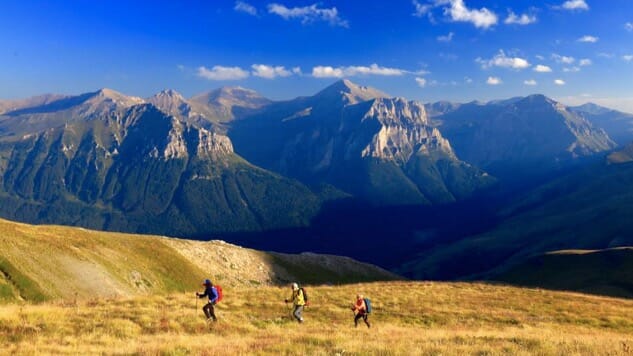The Western Balkans’ Via Dinarica Mega-Hiking Trail
A trekking route acts as cultural corridor across Old World Europe
Photography courtesy of Aleksandar Donev/Mustseedonia.com
Note: This piece is the Essential travel article in Paste Quarterly #1, which you can purchase here, along with its accompanying vinyl Paste sampler.
![]()
From the ledge atop the day’s final pass, a grassy, amphitheater-shaped clearing, encircled by mountains, appeared beneath us. The Albanian Alps rippled behind, marking our path from the last several days along the 1,200-mile Via Dinarica mega-hiking trail, which traverses all eight countries in the western half of the Balkan Peninsula. To the north, peaks towered above and lined the border with Montenegro. Directly ahead and to the east, a jagged collection of summits faded into Kosovo. On the valley floor below—the size of several city blocks—multiple flocks of sheep occupied quadrants of the expanse and moved with a balletic unison perfected over centuries in this corner of Southeastern Europe. They drifted like fluffy schools of fish or lethargic marching bands. Instead of music, however, the sound echoing up to our ridge was a cacophony of bleating and the clanging of atonal bells. Hyperactive herding dogs ran circles around the animals and nipped at band members breaking formation.
In the distance, and on the apron of the plateau, we could make out the nomadic shepherd village of Doberdol, our destination for the evening. The cluster of impromptu lean-tos, temporary shelters, and thatched-roof huts built of stacked flagstone was abuzz with families bringing in horses and filling jugs with stream water. Smoke curled from chimney pipes as villagers began feeding wood into iron stoves in preparation for dinner.
Over the past couple of months on the Via Dinarica, our Balkans-based crew of hikers—the number waxed and waned as we crossed borders and welcomed new friends or said goodbye to others—had grown accustomed to stumbling upon such Edenic locales. This trail, which traverses and connects Slovenia, Croatia, Bosnia and Herzegovina, Montenegro, Albania, Kosovo, Serbia, and Macedonia, had, in fact, been created, from 2010 to 2015, for just this kind of discovery. The route provides an authentic avenue to some of Europe’s last remaining Old World settlements and a corridor to an embarrassment of cultural riches. The path summits the region’s highest peaks, dips into valleys, passes lakes and rivers, and strolls along the cobbled streets of remote
villages. It can be walked for three months, three days, or three hours, depending on the stretch of land an adventurer has time to cover. As importantly, the trail unfurls like a variegated quilt, the squares stitched together across epochs and empires with the heritages, gastronomies, music and traditions of the South Slavs, Albanians, Greeks, Illyrians, Romans, Byzantines, Ottomans, Venetians and Austro-Hungarians all on display.
Our expedition team descended into the pasture. It was impossible not to feel overwhelmed by the majesty of the landscape—even for mountaineers who make a living hiking throughout the Via Dinarica region. Just as powerful though, was the palpable sense that we were part of a Balkans-wide, philosophical sea change in adventure tourism.
-

-

-

-

-

-

-

-

-

-

-

-

-

-

-

-

-

-

-

-

-

-

-

-

-

-

-

-

-

-

-

-

-

-

-

-

-

-

-

-








































